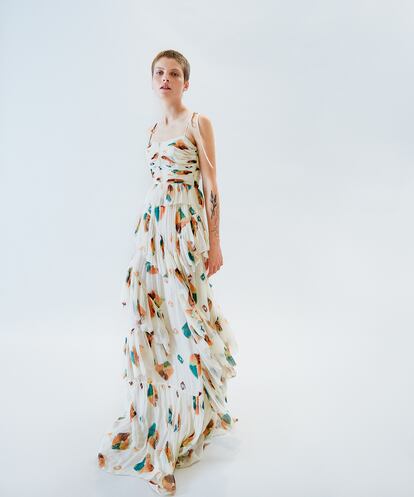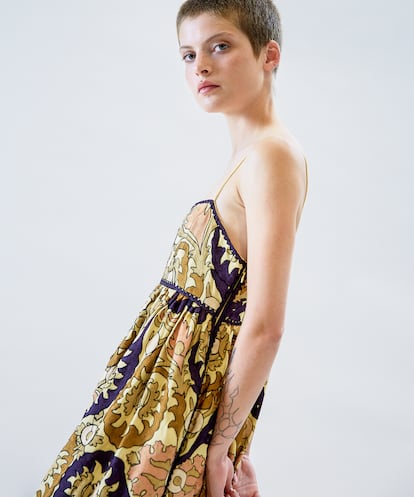Ulla Johnson, the New York designer who creates ‘future relics’
A champion of craftsmanship and sustainability, the fashion creator made her brand a global success without having to compromise her values

Fashion was not in her plans (she actually studied psychology and gender studies), but when she graduated in 2000, Ulla Johnson decided to do something with the artisanal fabrics that she collected from her trips with her parents, both archaeologists. Twenty years later, with a consolidated brand with more than 200 points of sale worldwide, she is still doing it. “The basis of our business is the communities of artisans, with whom we work to develop our collections; we usually work with women from Peru, Uruguay, Pakistan, India or Kenya. During the pandemic, which made it difficult for us to access certain countries, we found embroiderers and crochet artisans in Brooklyn, and we added them to the rest of the suppliers,” she explains.
Johnson has always believed in craftsmanship and sustainability (not just environmental, but also regarding human rights), even when no one was talking about it yet. When, at the beginning of the century, Barneys took an interest in her collection and began to sell it, getting other temples of luxury — both physical and digital — to notice her, the designer decided to slow down the pace of her expansion in order to become a mother and, during that break, think about where she wanted to take her business.

She did not take part in fashion shows until 2014, when her brand was already famous globally; in other words, when she could really afford it. “Now there’s more interest in handmade things and it’s wonderful, but for me fashion only makes sense when it has an emotional value for the person who wears it and, as far as I am concerned, as a designer, I can provide that if the material is handmade and if in the process I can add value and support the communities that make it,” she says. That is why, as she found artisans from different continents (she usually travels to meet them and work with them twice a year), she decided to raise her prices, which now range between $500 and $1,000: “It’s what’s fair if you want to pay the artisans well,” she explains. A few months ago, she launched a service on her website where her customers can sell used pieces from previous collections at lower prices, “and we have a customer service that helps clients find specific garments.”
In fact, Ulla Johnson likes to say that she designs “future heirlooms,” that is, emotionally charged garments meant to be passed on to future generations. That is why she does not want to get her firm involved with external investors or conglomerates, preferring to grow at a slow pace instead. And, at a time when other American brands are looking for a place in Paris or Milan, to do everything in New York, from her studio in Soho to her presentations, usually carried out in unusual sites, from Roosevelt Island to the Brooklyn Museum: “I don’t know what will happen in the future,” she explains, “but I was born here, and I built my business here. New York is what inspires me, and I think the city has a lot to do with what I do. Never say never, but for now I don’t see myself expanding or moving my business.”

That, of course, does not mean that the brand does not have medium-term plans. In the last five years, Ulla Johnson has expanded her business line “due to the demand of my customers,” she says. Now she not only designs those bohemian-style garments that made her famous: she also creates shoes, bags, jewelry and, starting this season, party dresses. “Our buyers asked for it, because the desire to dress up has returned — although, actually, what is really happening is that there is no longer a sense of being overdressed or underdressed. I myself am surprised when I decide to dress up to spend the day with my family,” she reflects.

That sums up Ulla Johnson’s creative process, a mix between what her customers want and what she herself would wear (in fact, her website includes a section dedicated to her wardrobe): “I wear my clothes every day and I design thinking about how this or that garment makes me feel. It’s my way of being honest with my clients, believing that if it’s easy for me to wear, it will also be for them,” she explains. “Everything I do, from the shape to the print, the zippers, or the pockets (I even put pockets in the party pieces that are shown on the runway) is designed to make you feel good and comfortable. I am not interested in what is only pretty but not real. I don’t want to overwhelm the consumer.”
Sign up for our weekly newsletter to get more English-language news coverage from EL PAÍS USA Edition
Tu suscripción se está usando en otro dispositivo
¿Quieres añadir otro usuario a tu suscripción?
Si continúas leyendo en este dispositivo, no se podrá leer en el otro.
FlechaTu suscripción se está usando en otro dispositivo y solo puedes acceder a EL PAÍS desde un dispositivo a la vez.
Si quieres compartir tu cuenta, cambia tu suscripción a la modalidad Premium, así podrás añadir otro usuario. Cada uno accederá con su propia cuenta de email, lo que os permitirá personalizar vuestra experiencia en EL PAÍS.
¿Tienes una suscripción de empresa? Accede aquí para contratar más cuentas.
En el caso de no saber quién está usando tu cuenta, te recomendamos cambiar tu contraseña aquí.
Si decides continuar compartiendo tu cuenta, este mensaje se mostrará en tu dispositivo y en el de la otra persona que está usando tu cuenta de forma indefinida, afectando a tu experiencia de lectura. Puedes consultar aquí los términos y condiciones de la suscripción digital.
More information
Archived In
Últimas noticias
Most viewed
- Reinhard Genzel, Nobel laureate in physics: ‘One-minute videos will never give you the truth’
- Oona Chaplin: ‘I told James Cameron that I was living in a treehouse and starting a permaculture project with a friend’
- Pablo Escobar’s hippos: A serious environmental problem, 40 years on
- Charles Dubouloz, mountaineering star, retires at 36 with a farewell tour inspired by Walter Bonatti
- Why we lost the habit of sleeping in two segments and how that changed our sense of time











































